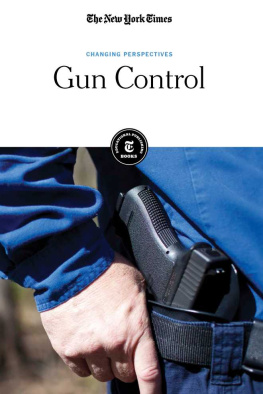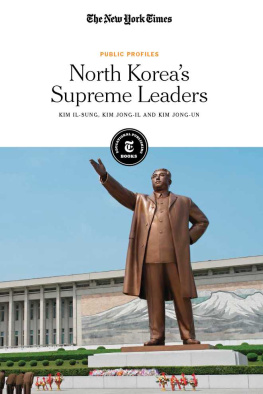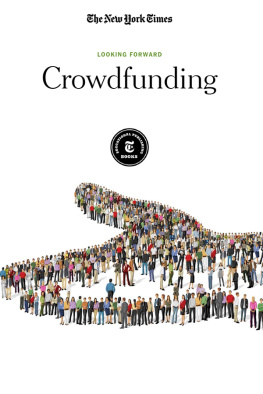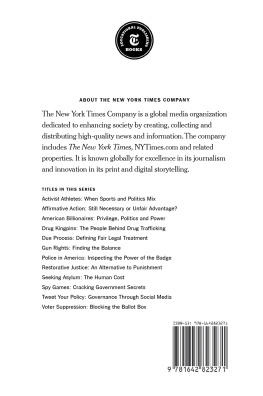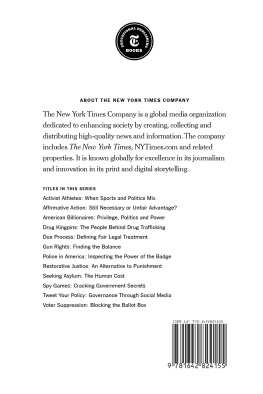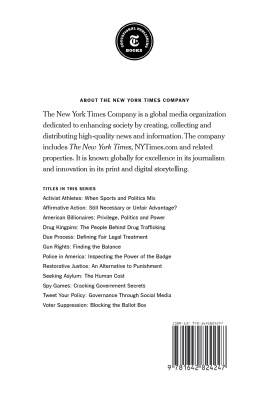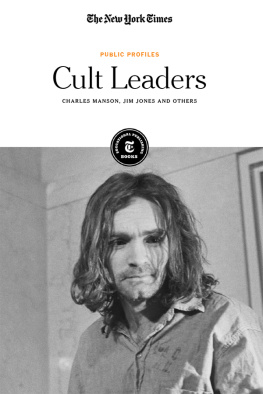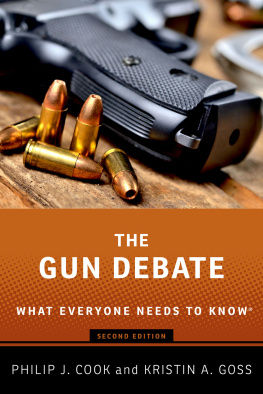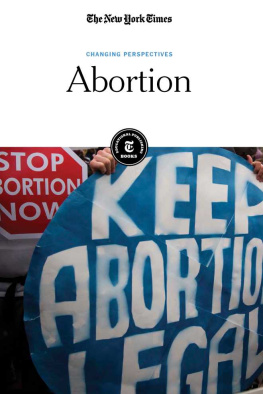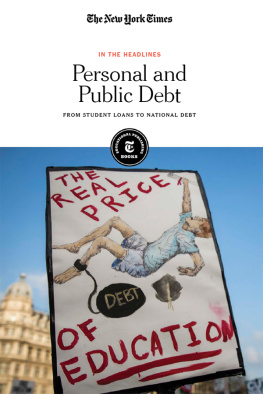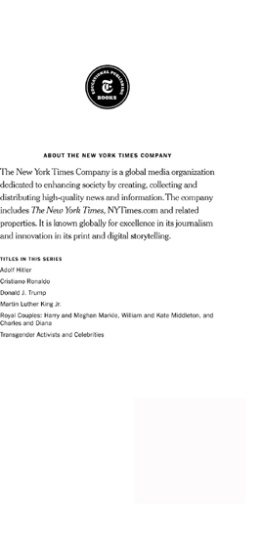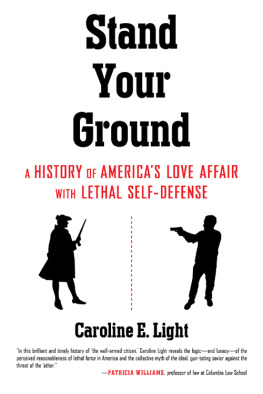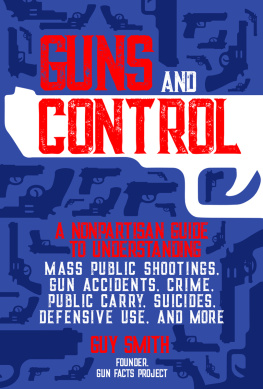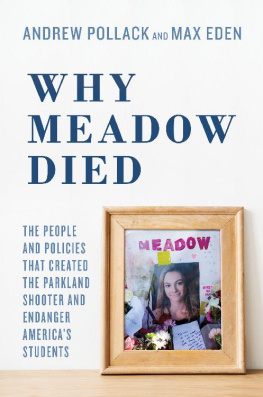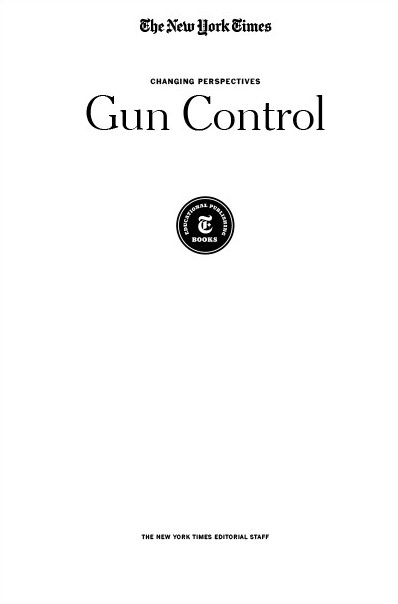Published in 2019 by The New York Times Educational Publishing in association with The Rosen Publishing Group, Inc.
29 East 21st Street, New York, NY 10010
Contains material from The New York Times and is reprinted by permission. Copyright 2019 The New York Times. All rights reserved.
Rosen Publishing materials copyright 2019 The Rosen Publishing Group, Inc. All rights reserved. Distributed exclusively by Rosen Publishing.
First Edition
The New York Times
Alex Ward: Editorial Director, Book Development Phyllis Collazo: Photo Rights/Permissions Editor Heidi Giovine: Administrative Manager
Rosen Publishing
Megan Kellerman: Managing Editor Elizabeth Schmermund: Editor Greg Tucker: Creative Director Brian Garvey: Art Director
Cataloging-in-Publication Data
Names: New York Times Company. Title: Gun control / edited by the New York Times editorial staff. Description: New York : New York Times Educational Publishing, 2019. | Series: Changing perspectives | Includes glossary and index. Identifiers: ISBN 9781642821468 (library bound) | ISBN 9781642821451 (pbk.) | ISBN 9781642821475 (ebook) Subjects: LCSH: Gun controlJuvenile literature. | Gun control United StatesJuvenile literature. Classification: LCC HV7435.G86 2019 | DDC 363.330973dc23
Manufactured in the United States of America
On the cover: A close-up of Jeff Nass, president of WI-FORCE, a gun rights group in Wis.; Narayan Mahon for The New York Times.
Contents
CHAPTER 1
Early Gun Control Measures
CHAPTER 2
The Reagan Years and Shifts in Gun Laws
CHAPTER 3
A Call for Greater Gun Control
CHAPTER 4
Millennial Changes in Gun Legislation
CHAPTER 5
Contemporary Calls to Action
Introduction
for many, guns are inextricably linked to both the history of the United States and the contemporary moment. Guns were an integral part of both our nations independence from Great Britain in the 18th century and the expansion of the western frontier in the 19th century. Those who believe that guns should not be regulated often cite the Second Amendment of our Constitution, which states, A well regulated Militia, being necessary to the security of a free State, the right of the people to keep and bear Arms, shall not be infringed. Advocates of gun control, however, see the Second Amendment as a historical document that must be reinterpreted in our contemporary moment; they believe that, for the Founding Fathers, a well regulated militia was essential to gaining independence and becoming a new nation, but it is less important today.
But times have certainly changed. While violence has always unfortunately played a large role in human societies, mass shootings have occurred more frequently in recent decades and have received more media attention. The definitions of a mass shooting differ, but it is generally considered to be the indiscriminate shooting and death of four or more people, not related to gang activity, other crimes or military action. In the United States, mass shootings were not part of broad public attention until Charles Whitman shot his wife and mother and then killed fourteen people from the clock tower at the University of Texas at Austin in 1966.
The 1960s also brought the assassinations of many high-profile political and civil rights figures, including John F. Kennedy, Malcolm X, Martin Luther King Jr. and Robert Kennedy, among many others. During this period of time, gun control measures were introduced in Congress and then blocked, largely through the lobbying of the National Rifle Association (N.R.A.). Although the N.R.A., which advocates for gun rights, has been in existence since 1871, it first began to lobby effectively against gun restrictions in the late 1960s and 1970s. The issue of gun control during this time was also inextricably linked with the civil rights movement and with racism. Gun rights advocates often stated that widespread gun ownership would help protect white people from attacks by other races, while those who were pro-gun-control argued that gun restrictions would keep guns out of the hands of black power groups like the Black Panthers. Unfortunately, the gun control debates of the 1960s and 1970s were largely steeped in bigoted and racist ideology.
The issue of gun control has been no less complex in the years since. Like the attack at the University of Texas in 1966, the 1999 school shooting at Columbine High School, in Colorado, became a watershed moment. Thirteen students and teachers were killed that day, and the nation broke out in fevered debate about the role of gun laws, bullying and mental health in such deadly attacks.

BILGIN SASMAZ/ANADOLU AGENCY/GETTY IMAGES
People in Chicago gather to remember the victims of a shooting spree in Las Vegas in October 2017 and to advocate for stricter gun control. More than 500 people were injured and 59 people were killed, making it the deadliest mass shooting up to that point.
Since then, school shootings seem to have become a much more common occurrence in the United States. From the 2012 attack on Sandy Hook Elementary School in Connecticut to the 2018 Santa Fe High School shooting in Texas, it appears as if we have reached a tipping point in terms of gun violence and schools. In particular, younger generations who are fatigued by the emotional stress of school shootings or who have lost loved ones in these attacks have begun to organize and speak out for greater gun control in the United States. They have experienced great resistance from the N.R.A. as well as from Republicans in Congress. However, this might be changing. With mass shootings almost becoming commonplace in the United States, more voices are speaking out for common-sense measures, such as a national registry of gun owners or mental health background checks. For advocates of gun control, the path appears rocky and long after all, gun control measures have been introduced and defeated in the U.S. Congress for over fifty years but there is reason to hope that change is nigh.
CHAPTER 1
Early Gun Control Measures
Gun control issues began to receive more widespread attention in the U.S. media in the 1960s. Despite a series of assassinations President John F. Kennedy in November 1963, Malcolm X in February 1965, Martin Luther King Jr. in April 1968 and Robert Kennedy in June 1968 many gun control efforts languished in Congress. The National Rifle Association, a gun-rights group, developed into a powerful voice against gun control during this period. However, the 1968 Gun Control Act, which regulated interstate traffic of firearms, was passed despite the group's objections.
Gun-Curbs Issue Revived by Dodd
BY BEN A. FRANKLIN | JAN. , 1965
Washington, jan. 16 The prospects for success of a renewed Congressional drive to restrict and control the growing mail-order trade in cheap guns have been enhanced this year.
The expected support of the Johnson Administration for firearms control legislation and the compliant attitude of the overwhelmingly Democratic congress are major factors, observers here believe.
The opposition to any gun controls has also grown. Although restrictions on mail-order guns are supported by the biggest and most influential shooters organization, the National Rifle Association, there are 15 million to 20 million hunters and gun enthusiasts in the country who are not affiliated with it.

